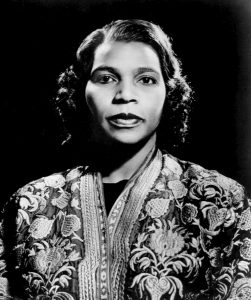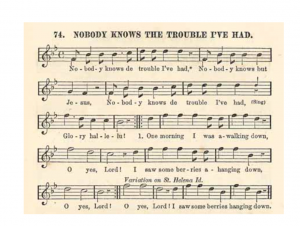Marian Anderson occupies a unique position in history. Born in 1897, the contralto represents the culmination of hundreds of years of musical transmission and development along with the continuously evolving nature of American Culture.
Her recording of Nobody Knows the Trouble I’ve Seen made in December of 1924,specifically, illustrates the complex history of spiritual transmission. First described as part of an 1866 description of a shout held in an old cotton gin house by an author named only M.R.S., and later transcribed in the 1867 collection Slave Songs of the United States, this shout, like many, has a rich transmission history. Since its initial transciption, the shout has been taken on tour by the Fisk Jubilee Singers and performed by a number of artist from Louis Armstrong to Mahalia Jackson (here’s a playlist of different versions of the Nobody Know’s the Trouble I’ve Seen). Below is the 1924 recording (remastered and brought to you courtesy of Spotify) of Anderson’s. Take a listen to the recording while you read the rest of this post.
So why this recording?
Anderson would debut in Europe at Wigmore hall in London in 1930, and later, would famously perform for a crowd of 75 000 at the Lincoln Memorial after she had been denied a performing space at Constitution Hall on racial grounds. Before all that, however, she made these recordings of spirituals, shouts, and work songs. What is striking about this recording of Nobody Knows the Trouble I’ve Seen is Anderson’s vocal technique and how that reflects contemporaneous American cultural ideologies.
The technique used on the recording echoes the sound Anderson uses in the works she most frequently performs; the Lied of Schubert. Her use of classical technique to cover a song that had once been a ring shout is telling of the way Nobody Knows the Trouble I’ve Seen has changed over time. While some may argue that her technique is simply a result of her classical training, I would posit a more insidious explanation. As the Fisk Jubilee Singers demonstrated through their early performances of traditional spirituals, often times the vocal technique used when singing spirituals had to be altered so that the original spiritual could be safe for white consumption. The emphasis on western tonality as the only acceptable and marketable base for music contributes to the erasure of diversity in the “American” musical canon. Zora Neale Hurston in her work Spirituals and Neo-Spirituals goes so far as to argue,
There never has been a presentation of genuine Negro spirituals to any audience anywhere. What is being sung by the concert artists and glee clubs are the works of Negro composers or adaptors based on the spirituals.
While this recording shows Marian Andersons’ devotion to performing spirituals, it also demonstrates how capitalist necessity and white supremacy absorb and appropriate any culture deemed to be “the other” and, in doing so, prohibit any genuine presentation of a spiritual.
Just a Note: The articles on Marian Anderson from the New Grove Dictionary of Music and Musicians and African American Music Reference focus heavily on her amazing performance at the Lincoln Memorial. Take a break from scholarly journals and learn more about it from this NPR article. Also, if you want to learn more about Anderson, check out this other playlist of her performing spirituals and pieces from the Western Classical canon.
Photographs From Marian Anderson’s Website
Works Cited
“Anderson, Marian, 1897-1993, by AMG, All Music Guide.” In All Music Guide: The Definitive Guide to Popular Music, 1. San Francisco, CA: Backbeat Books, 2001. Accessed October 3, 2017. http://search.alexanderstreet.com/view/work/bibliographic_entity%7Cbiography%7C438020.
Epstein, Dena J. Sinful tunes and spirituals: Black folk music to the Civil War. Urbana Chicago: University of Illinois Press, 1977.
Max de Schauensee and Alan Blyth. “Anderson, Marian.” Grove Music Online. Oxford Music Online. Oxford University Press, accessed October 2, 2017, http://www.oxfordmusiconline.com/subscriber/article/grove/music/00865.
Tick, Judith, and Beaudoin, Paul, eds. 2008. Music in the USA : A Documentary Companion. Cary: Oxford University Press, USA. Accessed October 2, 2017. ProQuest Ebook Central.
Williamson, Etta L. The Journal of Negro Education 26, no. 1 (1957): 38-40. doi:10.2307/2293324.
http://www.npr.org/2014/04/09/298760473/denied-a-stage-she-sang-for-a-nation
Slave Songs of the United States 1867


